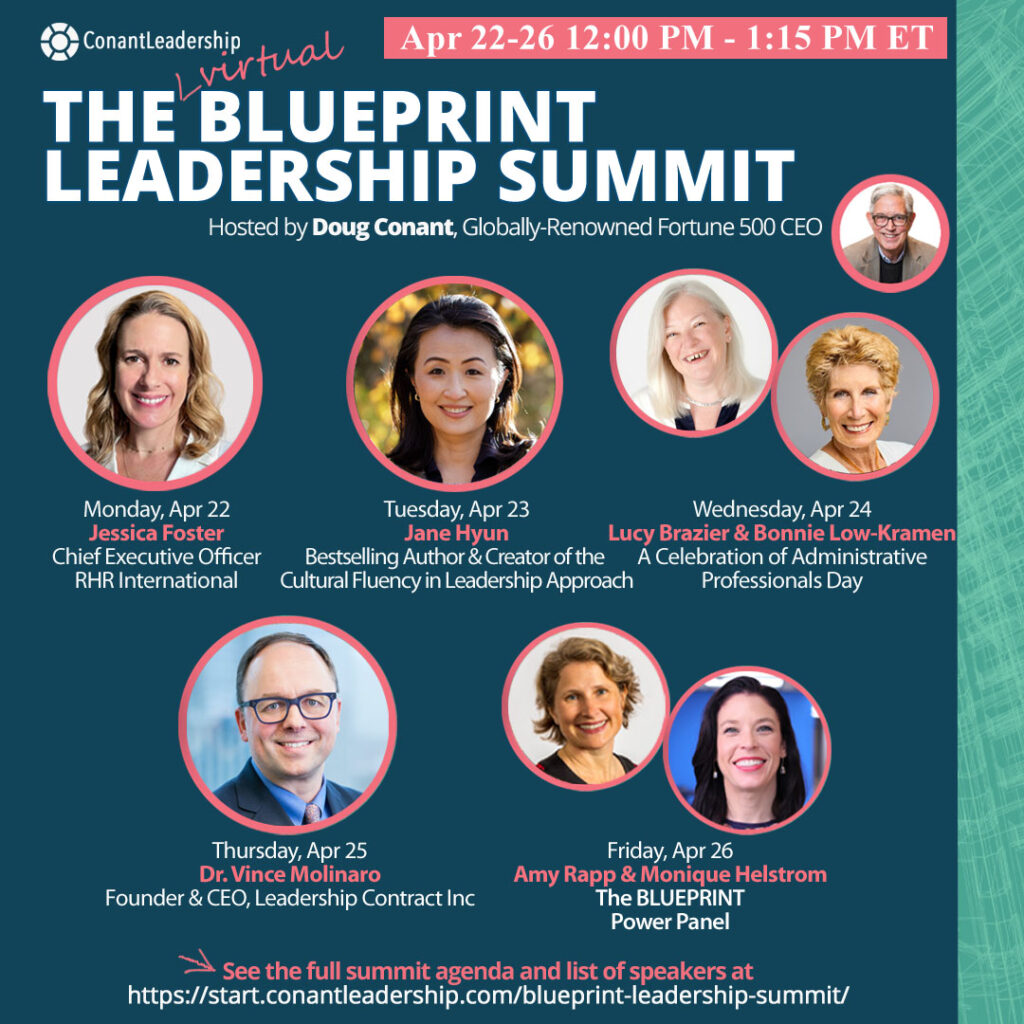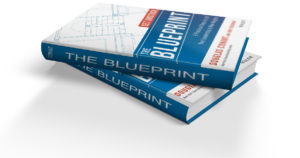
At ConantLeadership, we’re committed to lifelong learning and continuous improvement. In service to your leadership growth, each month we curate the Leadership That Works Newsletter, a digest of timely resources from around the web. We prepare this resource in order to:
- Share actionable advice from top leadership luminaries
- Celebrate a range of viewpoints (inclusion is not an endorsement)
- Contextualize workplace trends through a leadership lens
- Illuminate cultural recalibrations in the world of work
- Support your personal development in life, leadership, and beyond
In this month’s Leadership That Works Newsletter: Close the workplace well-being gap, CEO tips for thriving in chaos, how to normalize and manage conflict, a practical guide to ‘happierness,’ 4 thinking traps to avoid in stressful situations, and much more. As always, we’re sharing the content from our newsletter here on our blog in case you’re not subscribed to our mailing list. If you find these links enriching, you can sign up to receive our newsletter right here.
5 Keys to Emotional Regulation for Leaders
Leaders hold tremendous influence over the emotional health of their teams. If the leaders’ moods are tumultuous, a walking-on-eggshells apprehensiveness can spread throughout the organization.
1. Notice what you notice.
2. Feel the emotion before you start thinking about it.
3. Question your own explanations for your feelings.
4. Identify your own predictable patterns.
5. Make intentional choices to accept or change.
Get the full story here.
Closing the Workplace Well-Being Gap
“The conversation around workplace well-being continues to be top of mind for C-suite leaders and workers alike,” say the authors of this research-backed Deloitte Insights Magazine piece on the topic. Yet, despite an increased focus on programs and policies aimed at helping employees thrive, and a widespread recognition “that work is a critical determinant of well-being,” many initiatives are floundering and “don’t have clear measurements or accountability.” And studies show that that employee well-being has actually “worsened across dimensions, including physical, mental, social, and financial.” Deloitte’s Well-being at Work survey may point to the root issue: It shows “six significant disconnects” between leaders’ perceptions and employees’ realities. The authors say “leaders need to acknowledge these critical gaps and take action to close them.”
- The perception gap. “The C-suite appears to have an inaccurate perception of how their employees are actually faring.”
- The care gap. “while a majority of employees (71%) feel their coworkers care about their well-being (and 81% say they care about their coworkers), they’re less convinced that organizational leadership is concerned about their well-being.”
- The modeling gap. “Leaders are less transparent about their own well-being than they think they are.”
- The satisfaction gap. “While just 43% of employees are ‘very’ or ‘somewhat’ satisfied with their well-being benefits, 90% of the C-suite believes they are.”
- The priority gap. “Leaders and workers are at odds over how well organizations are prioritizing human sustainability.”
- The action gap. “Most workers expect their employer to advance human sustainability but companies are falling short.
Get the full story including tips for closing the gaps here.
Top CEOs Share 6 Leadership Strategies for Thriving in Chaos
“Worldwide, the past few years have been marked by multiple, intersecting crises—and things aren’t likely to get less complicated anytime soon,” write the authors of this Harvard Business Review article, which compiles CEO advice on how to lead through chaos.” The authors say that, “in this chaotic new world, organizations need leaders with inner strength, character, and a moral compass,” and emphasize that leaders who continuously adapt and learn can “enable their organizations to navigate these ever-turbulent waters.” A key differentiator is being proactive, not reactive. Leaders should be intentional about preparing for the future rather than merely “withstanding or responding” to change. The CEOs recommend six strategies.
1. Take care of yourself. “Just as we’re instructed to put on our own oxygen masks first, leaders must first take care of themselves before they can care for others.”
2. Lead with values. “In a world characterized by increasing volatility, our CEOs emphasize the importance of anchoring leadership around core values and principles, which remain stable even when the environment isn’t.”
3. Seeing opportunities. “In a world characterized by increasing volatility, our CEOs emphasize the importance of anchoring leadership around core values and principles, which remain stable even when the environment isn’t.”
4. Rethink your higher purpose. “CEOs found that challenging the company’s raison d’être and rethinking its purpose to address fundamental human needs enables them to focus the company on a long-term, value-creating agenda beyond the crisis-du-jour.”
5. Redefine winning. A purpose-driven culture should adopt purpose-driven metrics for success rather than just measuring “shareholder value.”
6. Create energy. “The current environment is so draining for employees that the leader’s primary responsibility is to become a chief energizing officer.”
Get the full story here.
**For more on this, explore our resources featuring insights from two of the CEO authors of this HBR piece: Check out our coverage of a conversation between Doug Conant and Hubert Joly, and then read our coverage of a recent conversation between Doug Conant and Bill George.
How to Normalize and Manage Conflict
In this Women Leaders Connect interview, Amy Gallo, author of How to Work with Anyone (Even Difficult People), shares tips for normalizing and managing conflict in the workplace. Her advice is shared through the lens of women leaders, who are often socialized to be more agreeable and conflict-adverse, but Gallo stresses that the tips are applicable across genders. She says that in a polarized world rife with disagreement, many workers and leaders alike are reticent to engage in tough conversations because the risks feel too high. But avoidance can actually make problems fester and worsen. Instead, Gallo urges leaders “to really try to normalize conflict,” especially if “you’re senior in an organization,” and remember that disagreements “are a part of interacting with other humans and they’re a critical part of doing work.” To make discussions more productive, Gallo advises reframing conflict, not as a cause of stress, but as a shared issue that “we’re trying to figure out.” She also highlights that different viewpoints are essential to producing good ideas: If everybody “saw eye to eye all the time, chances are that would not be an innovative organization.” So what’s the key to navigating this effectively? Gallo says the secret is a mix of “warmth and competence.” Try to find the right balance: “When you need to be assertive, when you need to drive a conversation forward, remember to bring in some warmth,” which can be achieved through empathy, humor, or conscious awareness of everyone’s concerns. Get the full story here.
Jung’s Practical Guide to ‘Happierness‘
1. Good physical and mental health. “Jung believed that getting happier required soundness of mind and body.”
2. Good personal and intimate relations, such as those of marriage, family, and friendships. “Close relationships are at the heart of well-being,” and “cultivating them will reliably increase happiness.”
3. Seeing beauty in art and nature. “Jung believed that happiness required one to cultivate an appreciation for beautiful things and experiences.”
4. A reasonable standard of living and satisfactory work. Brooks upgrades “satisfactory work,” to “meaningful work,” which requires “earned success (a sense of accomplishing something valuable) and service to others.”
5. A philosophical or religious outlook that fosters resilience. “Jung argued that a good life requires a way of understanding why things happen the way they do, being able to zoom out from the tedious quotidian travails of life, and put events—including inevitable suffering—into perspective.”
Get the full story here. (This story may require email registration to access).
Turn Down the Volume
We’ve all had work and life disrupted by loud, annoying noises: The motorcycle engine that revs down the street, the clacking din of a railroad, the thundering whoosh of an airplane. These environmental nuisances are irritating but largely viewed as harmless, fleeting distractions. However, a growing body of research covered in this Scientific American piece by Joanne Silberner, shows how our noisy world could be harming more than just our peace-of-mind and productivity: “Loud sounds can hurt your heart and blood vessels, disrupt your endocrine system, and make it difficult to think and learn.” It’s prudent for leaders to consider the ill effects of noisiness so they can adapt accommodations in workplaces, optimize their own working conditions, and encourage others to do the same. So how to minimize noise exposure on an increasingly loud planet? While Silberner finds that the best solution is to move out of noisier areas, she acknowledges that’s not often a realistic option. Regardless of where you live, she says “you can protect yourself from noise” in a variety of ways including using smartphone apps to monitor sounds, using noise-cancelling headphones and earplugs when appropriate, being intentional about programming quiet time into your day, and asking people around you “to turn sound down.” Get the full story here.
4 Thinking Traps to Avoid in Stressful Situations
The world is changing at a rapid pace and leaders need to be able to adapt to a dynamic environment on demand. Reacting nimbly sounds simple in abstract, but is often difficult in the heat of the moment. Former FBI Agent LaRae Quy has observed how anxiety can hijack the brain under duress causing leaders to “move into a ‘fight or flight’ mentality when confronted with a stressful situation.” In this SmartBrief post, Quy says once this survival mode is activated, leaders are susceptible to falling into four anxiety-fueled thinking traps. She identifies each of the traps and shares tips for avoiding them.
1. Catastrophizing. This thinking trap assumes the worst-case, “nightmare scenario.” It’s better to “stop the negative thought in its tracks,” by simply saying “no” to the thought in your mind.
2. Black-and-white thinking. “This all-or-nothing approach means we consider situations as good or bad without considering the gray areas.” Combat either/or thinking by consciously “considering other options.”
3. Overgeneralizing. “When we overgeneralize, we assume the same outcome even if the circumstances differ.” To avoid this trap, remove words like “never,” “always,” and “everybody” from your inner monologue.
4. Mind reading. This trap “assumes we know what others are thinking about us even when we have no evidence to prove that it is true.” You can avoid it by challenging your assumptions.
Get the full story here.
**For more on avoiding limiting mindsets, explore our post on mastering an ‘abundance mindset’
Stop Believing These 9 Productivity Myths
Myth 2. Busy = Productive. Instead, “focus on the impact, not the activity.”
Myth 3. The more hours you work, the more you achieve. In reality, “quality comes before quantity.”
Myth 4. You need a rigid routine to be productive. Instead, “add flexibility to your schedule.”
Myth 5. You need a fancy productivity system to be efficient. In reality, “what works for others may not work for you. Find a system that meets your needs.”
Myth 6. Technology is the ultimate productivity booster. In reality, “information overload” can be counterproductive and “a mindful relationship with technology” is best.
Myth 7. A ‘clean desk’ leads to a clear mind. In reality, while this is true for some, it isn’t universal. You should “find your personal workplace sweet spot.”
Myth 8. You have to strive for ‘inbox zero.’ Instead, “focus on managing your inbox, not emptying it . . . don’t let emails dictate your days.”
Myth 9. Working from anywhere, anytime is a dream. While remote work has many benefits, “constant accessibility can make it difficult to truly unwind from work,” so make sure to “establish clear boundaries between personal and work time.”
Get the full story here.
Insights & Resources from ConantLeadership
 Did You Miss The BLUEPRINT Leadership Summit?
Did You Miss The BLUEPRINT Leadership Summit?
Our celebrated, bi-annual meeting of top leadership minds and luminaries returned this April featuring lively, daily discussions about the most pressing issues facing today’s workplaces. If you missed it, no worries. You can find video replays of all five sessions below.
1. How to Unlock Limitless Leadership Potential – A Conversation with Jessica Foster
2. Leading with Cultural Fluency – Insights from ‘Leadership Toolkit for Asians’ with Jane Hyun
3. Finding Your Leadership Superpower(s) as an Administrative Professional – A Conversation with Lucy Brazier & Bonnie Low-Kramen
4. The Secrets to Inspiring a Culture of Accountability – A Conversation with Dr. Vince Molinaro
5. The BLUEPRINT Power Panel – A Conversation with BLUEPRINT Boot Camp Alumni Monique Helstrom & Amy Rapp
‘Build a Courage Ladder’—2 Top Leaders on How to Be Competently Courageous
In this new blog resource, Doug Conant and Jim Detert, two top leadership experts, give practical leadership advice for learning how to be competently courageous in a chaotic world.
Doug Conant on The Warren Bennis Leadership Institute Podcast
Doug Conant shares personal stories on this podcast about how he works to carry the leadership legacy of Warren Bennis with him every day.
52 Quotes about Trust and Leadership
Given the importance of trust, especially today, it comes as no surprise that this roundup of trust quotes has been one of our most popular posts of all time. So we’ve updated the piece as an “encore” with five new bonus quotes from ConantLeadership Founder, Doug Conant.
March’s‘ Leadership That Works Newsletter
In last month’s newsletter: Don’t avoid tough topics, 4 questions to jumpstart culture change, how to sell your ideas, the difference between analysis and understanding, why ‘transformational’ leadership is better than ‘transactional’ leadership, and more.
 About the Author: Amy Federman is ConantLeadership’s Director of Content and Editor in Chief, and co-author with Doug Conant of the WSJ bestseller, The Blueprint.
About the Author: Amy Federman is ConantLeadership’s Director of Content and Editor in Chief, and co-author with Doug Conant of the WSJ bestseller, The Blueprint.
(Cover photo by Udit Chandra on Unsplash)





